Sanamahism
Sanamahism

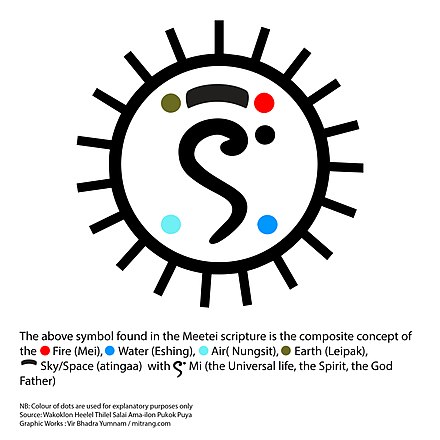 Sanamahism or Sanamahi religion (former official name: Lainingthouism or Lainingthou religion), commonly known as Meiteism or traditional Meitei religion or Pre-Hindu Manipuri religion or Kangleism or Kanglei religion, is an ancient ethnic religion of the Meitei people (popularly called Manipuri people) of Manipur. It traced its origin to Ancient Kangleipak (AKA Antique Manipur), the archaic Meitei civilization. It is the fastest growing religion and the fourth largest religion in Manipur according to 2001-2011 census reports. Sanamahism is named after Meitei God "Lainingthou Sanamahi", the most important deity among the gods and goddesses of this polytheistic faith.
Sanamahism or Sanamahi religion (former official name: Lainingthouism or Lainingthou religion), commonly known as Meiteism or traditional Meitei religion or Pre-Hindu Manipuri religion or Kangleism or Kanglei religion, is an ancient ethnic religion of the Meitei people (popularly called Manipuri people) of Manipur. It traced its origin to Ancient Kangleipak (AKA Antique Manipur), the archaic Meitei civilization. It is the fastest growing religion and the fourth largest religion in Manipur according to 2001-2011 census reports. Sanamahism is named after Meitei God "Lainingthou Sanamahi", the most important deity among the gods and goddesses of this polytheistic faith.
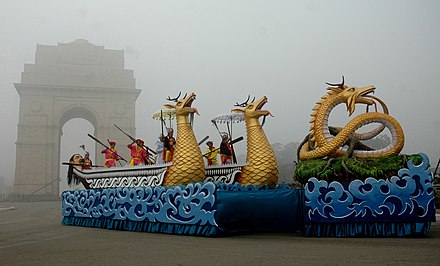
The world's only market run exclusively by women shopkeepers is the "Ima Keithel" (AKA "Ima Market", meaning "mothers' market") of Imphal, Manipur. It is one of the matters of pride of Sanamahism/Traditional Meitei religion. The Government of Manipur passed a law that no men can sell anything as shopkeepers but they can buy as customers inside the market. This market has 3 building complexes. The building complex number 1 is called "Leimarel Sidabi Ima Keithel". It is named after Meitei mother earth goddess, "Leimarel Sidabi". The building complex number 2 is called "Emoinu Ima Keithel". It is named after Meitei goddess of wealth and prosperity, "Emoinu" (alias "Imoinu"). The building complex number 3 is called "Phouoibi Ima Keithel". It is named after Meitei goddess of agriculture, harvest and food, "Phouoibi" (alias "Phouleima"). It is one of the greatest examples of women empowerment in the world.
There is no religion in the world except Sanamahism/Traditional Meitei faith that has a God dedicated to polo sports. Ancient Meitei God Marjing is worshipped as the God of polo sports and horses. Mythologically, He invented the game of polo (Modern Meitei: Sagol Kangjei, Ancient Meitei: Sakol Kangchei) and brought up the population of the Meitei horses (Manipuri ponies). Meitei players of polo in Manipur worship God Marjing before and after any polo match. The world's oldest Polo Ground is the Imphal Polo Ground of Imphal, Manipur, where American, Europe and Australia polo players come to play during the annual "Manipur Polo International Tournament". These players often visit the pantheon of God Marjing to offer prayers, even though they belong to different religious groups.
Understand
 Sanamahism/traditional Meitei ethnic religion has many religious aspects including animism (divine spirits of water, vegetation, trees, etc.), polytheism (many deities), shamanism (practitioners/shamans connecting to the gods), spiritualism (afterlife and souls) and totemism (sacred objects or symbols).
Sanamahism/traditional Meitei ethnic religion has many religious aspects including animism (divine spirits of water, vegetation, trees, etc.), polytheism (many deities), shamanism (practitioners/shamans connecting to the gods), spiritualism (afterlife and souls) and totemism (sacred objects or symbols).
The Meitei people were once an ethno-religious ethnicity (ethnic group that believes in only one faith) before the vast majority of them underwent forced conversion to Hinduism during the 18th century AD. A little population of the Meitei ethnicity has now also converted into Christianity and Buddhism. Most of the Buddhist Meiteis live in Myanmar (Burma).
The followers of Sanamahism are called Sanamahists. The Sanamahist population accounts for 8% of the total population of Manipur, according to 2011 census.
Destinations and sites
- Iputhou Pakhangba Laishang Temple, Imphal, 24.808°, 93.941°. This temple is dedicated to Meitei God Pakhangba. It is situated in the heart of the historic Kangla, in Imphal West district of Manipur. free (excluding the charges for visiting the entire historic Kangla fort/palace site)
- Lainingthou Sanamahi Kiyong Hongba Temple, Imphal, 24.804°, 94.035°. 24 hours. This temple is dedicated to Meitei God Lainingthou Sanamahi. It is situated on the hilltop of the Selloi Langmai Ching Hills, in Imphal East district of Manipur. free
- Ibudhou Marjing Temple, Heingang, Imphal, 24.876°, 93.950°. This temple is dedicated to Meitei God Marjing, the only deity of polo sports in the world. It is situated on the foothills of the Heingang Ching Hills of the Kontha Khabam region in Imphal East district of Manipur. free
- Sanamahi Temple, Imphal, 24.798°, 93.939°. This temple is dedicated to Meitei God Lainingthou Sanamahi and his foster mother Goddess Leimarel Sidabi. It is situated in the Sanakhwa Yaima Kollup, in Imphal West district of Manipur. free
- Hiyangthang Lairembi Temple, Hiyangthang, 24.726°, 93.903°. This sacred shrine is dedicated to Meitei Goddess Hiyangthang Lairembi (alias Irai Leima), the female deity of water. Historically, the shrine was heavily mixed with Hindu culture that many Hindus believe this Meitei goddess as Hindu goddess Durga. So, this temple is extremely busy during the traditional Meitei festivals like Lai Haraoba, Panthoibi Iratpa, etc. as well as Hindu festival like Durga Puja, as both Sanamahists & Hindus visit the temple.
- Konthoujam Tampha Lairembi Temple (Konthoujam Lairembi gi Khubam), Sagoltongba Mayai Leikai, Salam Keikhu, Konthoujam village, 24.767°, 93.852°. 24 hours. This Sacred Grove is dedicated to Meitei Goddess Konthoujam Tampha Lairembi, the former chief consort of God Salailen, the King of Heaven. Her mythology revolves around the sacred site. Many archaeologists and historians visit this place because of the presence of Meitei stone inscriptions. Many biologists visit this place because of the presence of rare vegetation inside the reserved sacred groves. The grove is dominated by the centuries old banyan trees connecting one another. Remarkably, a pair of long concrete dragon boats are also installed near the northern entrance gate to the sacred shrine. At the same time, many devotees and pilgrims visit the place for worshipping the mother goddess Tampha. free
- Puruk Shoubi sacred site, Imphal, 24.756°, 93.966°. This holy site is dedicated to Meitei God Pakhangba. It is well known for a sacred pond, whose waters are collected by devotees for the spiritual cleansing and purification of their bodies. It is situated in the middle of the farmlands in Kongba region in Imphal East district of Manipur. free
- Ebudhou Khumanpokpa Temple, Karang Island, Thanga-Karang Archipelago, Loktak Lake, 24.546°, 93.833°. This temple is dedicated to Meitei God Khuman Pokpa (alias "Khuman Apokpa"), the deity of night and darkness and the progenitor of the Khuman clan. The temple is adjacent to a park. It is situated in the middle of the Karang island in the middle of the Loktak Lake. To reach the place, one needs to take a boat ride from the nearest port of the Thanga island. free (except for your personal boating fees to reach the island)
- Khwairakpa Erel, Lakhipur, Cachar district, Assam, 24.726°, 93.067°. 24 hours. This sacred island hosts a small shrine dedicated to Meitei God Khwairakpa (popularly called "Nongpok Ningthou"). The island is situated in the middle of the Barak River. It is the most popular pilgrimage site for the Sanamahists/traditional Meitei faith followers in Assam. free (except for your personal boating fees to reach the island)
- Kwatha Laibung, Kwatha Meetei, Kwatha, Chandel district, Manipur, 24.337°, 94.278°. Most of the Meitei people in this place follow Christianity. However, they preserve the sacred site for the pilgrims of traditional Meitei faith followers and lovers.
- Lai Nongshaba Temple, Thanga Island, Loktak Lake, 24.532°, 93.826°. This temple is dedicated to Lai Ningthou Nongshaba, the Dragon Lion God. It is situated in the beach of the Loktak Lake, just next to the roadways. free
- Nongpok Ningthou Nongpok Panthoibi Shanglen, Moreh, India-Myanmar border town, 24.250°, 94.300°. This temple is dedicated to God Nongpok Ningthou and Goddess Panthoibi. The building structure is easily identifiable as it has distinct red colored roofs.
Do
Festivals
Lai Haraoba
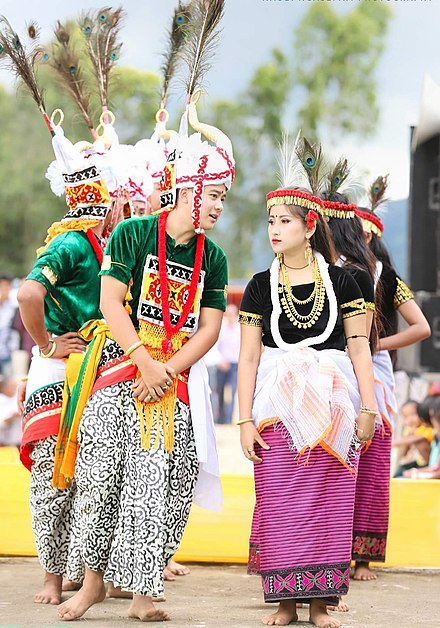 Lai Haraoba festival is a sacred festival of Sanamahism. It has no fixed dates according to Meitei calendar. Because this festival isn't dedicated to a particular god or goddess. This festival is celebrated to please many Meitei deities, whose sacred shrines are situated in different places. Local authorities of the shrines or temples fixed the dates of celebration of the Lai Haraoba festival for their respective places. In some places, it's celebrated for many months while in some places, it's celebrated only for one month. Around one month of time is the shortest duration for any Lai Haraoba festival. April to May is the timing when most of the people will celebrate the Lai Haraoba festival.
Lai Haraoba festival is a sacred festival of Sanamahism. It has no fixed dates according to Meitei calendar. Because this festival isn't dedicated to a particular god or goddess. This festival is celebrated to please many Meitei deities, whose sacred shrines are situated in different places. Local authorities of the shrines or temples fixed the dates of celebration of the Lai Haraoba festival for their respective places. In some places, it's celebrated for many months while in some places, it's celebrated only for one month. Around one month of time is the shortest duration for any Lai Haraoba festival. April to May is the timing when most of the people will celebrate the Lai Haraoba festival.
This festival consists of different dance forms, musical instrument performances, foods and drinks offered to the gods and the goddesses, lifting up the statues or idols of the deities on the palanquins and roaming at the streets to please the deities. Every single events have their respective philosophical meanings.
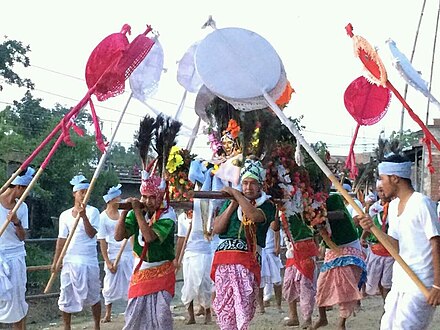 People following any religion can witness the festival but to join the dancing, singing, etc. may or may not be allowed. It depends from place to place. If you want to participate, first seek permission from the festival organizing religious authorities.
People following any religion can witness the festival but to join the dancing, singing, etc. may or may not be allowed. It depends from place to place. If you want to participate, first seek permission from the festival organizing religious authorities.
Sanamahi Ahong Khong Chingba (Sanamahi Cheng Hongba)
The Sanamahi Ahong Khong Chingba festival or the Sanamahi Cheng Hongba festival was banned for around 350 years from celebrating since the 18th century AD by the Hindu kings in Manipur until the traditional Meitei revivalist movements brought life to this suppressed cultural element back. Hindu festival of slightly similar features, named the "Rath Yatra", replaced the celebration in Manipur. However, in the year 2018 AD, since there's no monarchy rule in Manipur, Sanamahist people took the freedom of reviving the celebration of the festival. This festival is dedicated to God Sanamahi, the most important deity of Sanamahism. This festival is called Sanamahi Cheng Hongba because devotees offer rice to God Sanamahi in bulk. This festival is also called Sanamahi Ahong Khong Chingba because devotees pull a small chariot housing an idol of God Sanamahi, through ropes. The chariot pulling ceremony is widely celebrated in the busy streets of Imphal, the metropolis of Manipur. The pulling of the God's chariot across the streets of the city during this festival was a common practice since ancient times. It has deep philosophical meanings to convey. It spiritually symbolises the circumambulation (moving around a sacred object) of the earth by God Sanamahi during primordial times according to ancient Meitei mythology (old Manipuri mythology).
There's no hard and fast rules that people of other religions can or cannot participate. In fact, everyone is allowed to join. However, Hindus will find many differences between the Hindu festival Rath Yatra and this traditional Meitei religious festival, even though the common feature is pulling a chariot.
Respect
Sanamahism/Traditional Meitei ethnic religion is sometimes attempted to be considered or treated as a sub-section/sect/denomination of Hinduism by some group of people. Such considerations and treatments are considered as disrespect and illegal according to the "Freedom of Religion" of the Indian Constitution as well as several international legal bodies.
The traditional Meitei ethnic religion is considered as a civilised culture by most of the Meitei people. So, the usage of the English language terms like "tribalism", "tribal faith" or "tribal religion" is considered as a disrespect by most of its followers. Even according to the Indian law, among the 4 types of legally categorised groups of Indian people - (1) General (GEN), (2) Scheduled Caste (SC), (3) Scheduled Tribe (ST) and (4) Other Backward Classes (OBC), Meitei people aren't legally considered as Scheduled Tribes (ST). So, the usage of tribe-related terms to refer to the Meitei culture is considered as offensive, except for some special cases.
Sanamahism allows people of any faith in entering the Sanamahist/traditional Meitei religious shrines or temples or any other holy sites. Everyone should remove their shoes, slippers and socks before entering into the sacred sites. Otherwise, it's considered as a disrespect. Wear shoes that can be slipped on and off easily, particularly if you're planning to visit a lot of temples.
Usually, either near the gate or near the entrance door of most traditional Meitei holy shrines, leaves of Tairen plant (Toona ciliata) are kept immersed in a clean water vessel. Every visitors are supposed to hold the leaves and sprinkle a little of the water on their heads or upper body parts. It is supposed to spiritually cleanse the body of the visitors. In some places, such sprinkling of water with leaves are done by maibas (priests) or maibis (priestesses) in service of the temples. If a maiba or a maibi isn't present, you can sprinkle the water by yourself.
Sanamahism is a faith with little population of followers. It is always struggling to thrive among the gigantic population of other major religions. Being a minority religion, it faces impacts and influences from other religious cultures, especially from Hinduism.
Talk
Classical Meitei language (officially known as Classical Manipuri language) is the liturgical language of Sanamahism (ancient Meitei religion). This standardised form of Meitei language is used to chant sacred hymns and prayers. The classical form of Meitei language is very different from the present day spoken Meitei. The word meanings are so complex that if not rendered properly by a language expert or an experienced scholar, a statement or a speech in Classical Meitei may get translated with contrasted meanings.
Eat
Sanamahism (Meiteism) doesn't allow its followers to consume eels, snakes or any other reptiles of similar appearances.
Beef and pork are neither banned nor promoted in general. However, in some religious sects/denominations of Sanamahism (Meiteism), pig meats are offered to gods and goddesses.
Practices of animal sacrifices were prevalent in old times. In modern days, since there are many wildlife protection laws regulated, such practices aren't usually allowed. However, for those animals that aren't mentioned in the wildlife protection laws and are found matching for the sacrificial rites and rituals according to Meitei religious beliefs, they are still sacrificed.
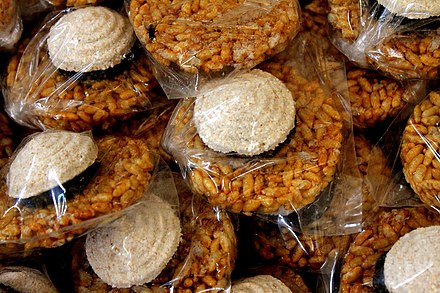
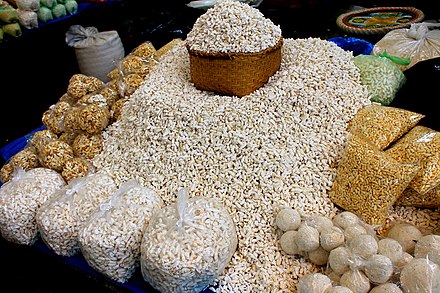
Drink
Some sects of Sanamahism allow the consumption of wine/alcoholic drinks. However, some sects consider such drinks as profane.
The places in Manipur where wine/alcoholic drinks are used for religious purposes are Andro, Kakching, Khurkhul, Phayeng, Sekmai, etc.
Learn
Dance forms
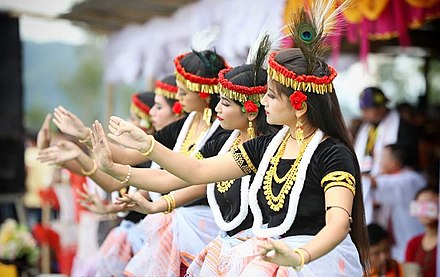 Many Meitei associations and organizations teach different dance forms of traditional Meitei culture. Popular dances are:
Many Meitei associations and organizations teach different dance forms of traditional Meitei culture. Popular dances are:
- Khamba Thoibi Jagoi (Khamba Thoibi dance) — the most popular dance form, the romantic ritualistic dance of Prince Khamba of Khuman dynasty and Princess Thoibi of Moirang dynasty
- Chukpharon Jagoi (Chukpharon dance) — a dance to please the 4 guardian gods of the 4 directions
- Laiching Jagoi (Laiching dance) — a dance form performed by the maibis (Meitei priestesses) to summon/call for a deity, by using the leaves of the Langthrei plant (Blumea balsamifera)
- Laihou Jagoi (Laihou dance) — a dance form performed by the maibis (Meitei priestesses) for the opening ceremony of the Lai Haraoba festival
- Leima Jagoi (Leima dance/Queen's dance) — a dance form especially reserved for royal women in the days of monarchy, but a public property in present day times
- Leisem Jagoi (Leisem dance/earth creation dance) — a dance form performed by both male and female dancers, acting as gods and goddesses, creating the earth and the universe
- Maibi Jagoi (Maibi dance/Priestesses' dance) — a ritual dance form performed by the maibis (Meitei priestesses)
- Panthoibi Jagoi (Panthoibi dance) — a romantic dance form performed by Goddess Panthoibi with her lover God Nongpok Ningthou, depicting their divine union
- Thougal Jagoi (Thougal dance) — a dance form performed by male and female dancers together to invoke many deities. ("Thougal" means "selfless service" in Meitei language)
Martial arts
Many Meitei associations and organizations teach Huiyen Langlon martial arts. Huiyen Langlon has two types - weaponry and weaponless forms. The weaponry martial arts form is called Thang-Ta. The weaponless martial arts form is called Sarit Saraak (Sarit Sarak). This martial arts form is believed to be founded by Meitei God Pakhangba according to Ancient Meitei mythology (Old Manipuri mythology).
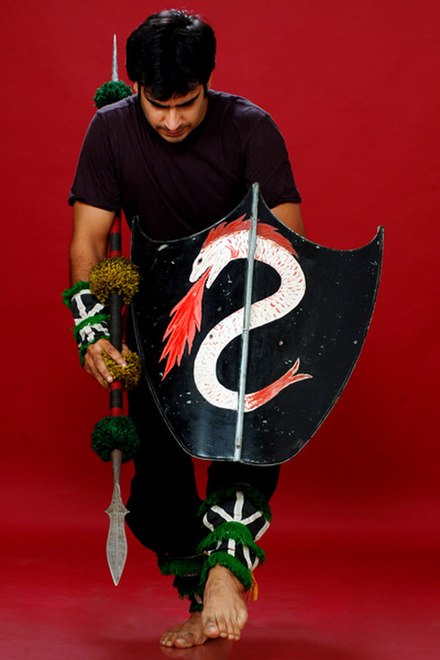
.jpg/440px-%EA%AF%81%EA%AF%94%EA%AF%A4%EA%AF%A0_%EA%AF%81%EA%AF%94%EA%AF%A5%EA%AF%9B_-_%EA%AF%83%EA%AF%88%EA%AF%A5%EA%AF%97_%EA%AF%88%EA%AF%A8%EA%AF%96%EA%AF%A6%EA%AF%A1%EA%AF%97_%EA%AF%8C%EA%AF%A6%EA%AF%A0%EA%AF%80%EA%AF%A4_%EA%AF%80%EA%AF%A5%EA%AF%94%EA%AF%9F_%EA%AF%84%EA%AF%A5%EA%AF%A2%EA%AF%95_(%EA%AF%B4).jpg) Among the weaponry and the weaponless forms, the weaponry form, Thang Ta is the more popular one.
The Meitei martial arts form, "Thang Ta" is one of the 2 most celebrated martial arts forms of India, besides the Kalari martial arts of Kerala.
There are many Huiyen Lallong (Huiyen Langlon) associations organised in many countries other than India, including United States of America (USA), Afghanistan, Bangladesh, Burma (Myanmar), Bhutan, Canada, China, Indonesia, Iran, Japan, Malaysia, Nepal, Nigeria, Pakistan, Philippines, Singapore and Sri-Lanka.
All its international achievements are possible because of the dedicated contributions from the "World Thang Ta Council" (WTTC), also known as the "World Thang Ta Federation" (WTTF).
Among the weaponry and the weaponless forms, the weaponry form, Thang Ta is the more popular one.
The Meitei martial arts form, "Thang Ta" is one of the 2 most celebrated martial arts forms of India, besides the Kalari martial arts of Kerala.
There are many Huiyen Lallong (Huiyen Langlon) associations organised in many countries other than India, including United States of America (USA), Afghanistan, Bangladesh, Burma (Myanmar), Bhutan, Canada, China, Indonesia, Iran, Japan, Malaysia, Nepal, Nigeria, Pakistan, Philippines, Singapore and Sri-Lanka.
All its international achievements are possible because of the dedicated contributions from the "World Thang Ta Council" (WTTC), also known as the "World Thang Ta Federation" (WTTF).
Meitei writing system (ancient & modern)
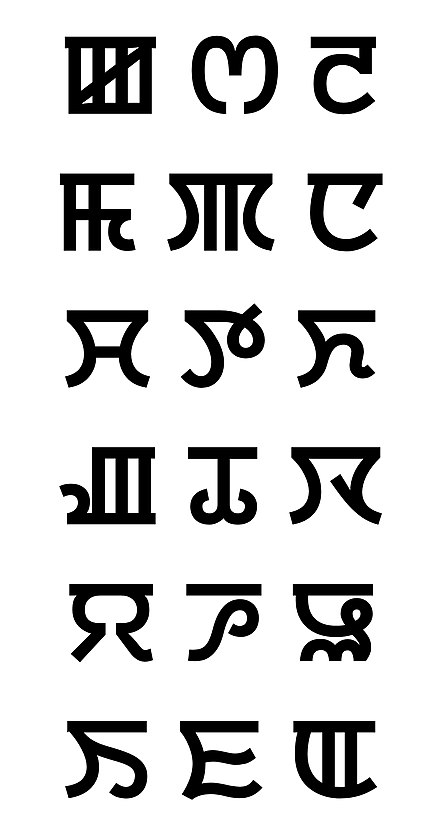 Since Meitei script is considered the holy writing system according to Sanamahism (Meiteism), many associations and organizations teach how to write and read the Meitei script to interested people at free of cost or only with a little fee. You can have access to learn both the ancient writing system as well as the modern writing system of the Meitei script.
Since Meitei script is considered the holy writing system according to Sanamahism (Meiteism), many associations and organizations teach how to write and read the Meitei script to interested people at free of cost or only with a little fee. You can have access to learn both the ancient writing system as well as the modern writing system of the Meitei script.
Stay safe
Due to the fact that Sanamahism/traditional Meitei faith is not a very commonly known religion, there might be the possibility of scams that prey on tourists' lack of knowledge of traditional Meitei customs. Here are some points to take note of as the precautionary measures so that you can avoid a few of the common scams:
- Meitei maibas/priests/shamans and maibis/priestesses do not sell religious items. Compounds of the Shrines/Temples may have shops selling religious items. These are always staffed by laymen and not by religious people.
- Meitei maibas/priests/shamans and maibis/priestesses do not go on for alms rounds, unlike other religions. Instead, they would either grow their own food or buy it using temple donations. Most of them are also required to be vegetarian.
- Traditional Meitei Shrines/Temples may or may not have donation boxes for followers to place their money donations. It is entirely up to you to decide whether or how much you wish to donate. If you want to donate some money, it's mandatory for your amount to be an "odd number" and not "even number". For example, you cannot donate 2 rupees, 4 rupees, 6 rupees, etc. If you want to donate, you should donate 1 rupee, 3 rupees, 5 rupees, etc.